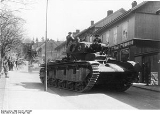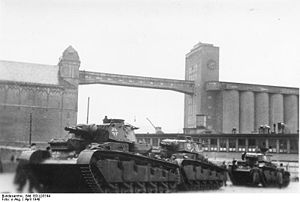
Neubaufahrzeug
Encyclopedia
The German Neubaufahrzeug series of tank
prototypes were a first attempt to create a heavy tank for the Wehrmacht
after Adolf Hitler
had come to power. Multi-turreted, heavy and slow, they did not fit in with the Blitzkrieg
tactics and therefore only five were made. These were primarily used for propaganda purposes, though three took part in the Battle of Norway
in 1940.
 During the 1920's and 1930's, a number of countries experimented with very large, multi-turreted tanks. The British built a single example of the Vickers A1E1 Independent
During the 1920's and 1930's, a number of countries experimented with very large, multi-turreted tanks. The British built a single example of the Vickers A1E1 Independent
in 1926. This inspired the Soviet T-35
, which was built in limited numbers from 1933.
Development of the Neubaufahrzeug (German for "new construction vehicle") started in 1933 when the then Reichswehr
gave a contract for the development of a Großtraktor (heavy tractor) to both Rheinmetall
and Krupp
. Grosstractor was a codename for the development of a heavy tank, Germany being still forbidden to develop tanks under the terms of the Treaty of Versailles
.
The two designs resembled each other to a great extent, the main difference being the weapons placement. Each had a main turret armed with a 75 mm KwK L/24 main gun and secondary 37 mm KwK L/45. Rheinmetall's design mounted the second gun above the 75 mm KwK L/24, while the Krupp design had it mounted next to the 75 mm KwK L/24. Both designs had a secondary turret mounted to the front and the rear of the main turret. These turrets were slightly adapted Panzer I
turrets, with the standard machinegun armament.
Rheinmetall's design was designated the PzKpfw NbFz V ('PanzerKampfwagen NeubauFahrzeug V'), and the Krupp design the PzKpfw NbFz VI. It was intended that these designs would fulfill the role of heavy tank in the armored forces, but the design proved to be too complex and unreliable for this role. Development nevertheless continued in order for the nascent German military to gain experience with multi-turreted tanks.
In 1934 Rheinmetall built two mild steel
prototypes, both with their own turret design. Three more prototypes were built with proper armor and the Krupp turret in 1935 and 1936.
 Though these tanks were never placed in production, they provided a propaganda tool for Nazi
Though these tanks were never placed in production, they provided a propaganda tool for Nazi
Germany, for example being shown at the International Automobile Exposition in Berlin
in 1939.
This propaganda role was extended with the German invasion of Norway, when a special Panzerabteilung was formed which took the three armored prototypes with them to Oslo
. They saw some combat there, with one being blown up by German engineers when it got stuck in swamps near Åndalsnes
. To replace it, one of the mild steel prototypes was used.
It is unclear what happened to the tanks after the Norway campaign, but none of them survived the war. The surviving vehicles were ordered scrapped in 1941, which took place in 1942 according to documents captured by the British in 1945. The dates upon which the vehicles were scrapped are unclear, but it is thought that the beginning of the construction of the Sturer Emil
prototypes dates from the same time.
All that survives of these tanks is a small number of Running gear
parts, preserved in the Gudbrandsdal Krigsminnesamling (Gudbrandsdal War Memorial collection), at Kvam
in Norway.
Tank
A tank is a tracked, armoured fighting vehicle designed for front-line combat which combines operational mobility, tactical offensive, and defensive capabilities...
prototypes were a first attempt to create a heavy tank for the Wehrmacht
Wehrmacht
The Wehrmacht – from , to defend and , the might/power) were the unified armed forces of Nazi Germany from 1935 to 1945. It consisted of the Heer , the Kriegsmarine and the Luftwaffe .-Origin and use of the term:...
after Adolf Hitler
Adolf Hitler
Adolf Hitler was an Austrian-born German politician and the leader of the National Socialist German Workers Party , commonly referred to as the Nazi Party). He was Chancellor of Germany from 1933 to 1945, and head of state from 1934 to 1945...
had come to power. Multi-turreted, heavy and slow, they did not fit in with the Blitzkrieg
Blitzkrieg
For other uses of the word, see: Blitzkrieg Blitzkrieg is an anglicized word describing all-motorised force concentration of tanks, infantry, artillery, combat engineers and air power, concentrating overwhelming force at high speed to break through enemy lines, and, once the lines are broken,...
tactics and therefore only five were made. These were primarily used for propaganda purposes, though three took part in the Battle of Norway
Norwegian Campaign
The Norwegian Campaign was a military campaign that was fought in Norway during the Second World War between the Allies and Germany, after the latter's invasion of the country. In April 1940, the United Kingdom and France came to Norway's aid with an expeditionary force...
in 1940.
Development

Vickers A1E1 Independent
The Independent A1E1 is a multi-turreted tank that was designed by the British armaments manufacturer Vickers during the interwar period. Although it only ever reached the prototype stage it influenced many other tank designs....
in 1926. This inspired the Soviet T-35
T-35
The T-35 was a Soviet multi-turreted heavy tank of the interwar period and early Second World War that saw limited production and service with the Red Army. It was the only five-turreted heavy tank in the world to reach production but proved to be slow and mechanically unreliable...
, which was built in limited numbers from 1933.
Development of the Neubaufahrzeug (German for "new construction vehicle") started in 1933 when the then Reichswehr
Reichswehr
The Reichswehr formed the military organisation of Germany from 1919 until 1935, when it was renamed the Wehrmacht ....
gave a contract for the development of a Großtraktor (heavy tractor) to both Rheinmetall
Rheinmetall
Rheinmetall AG is a German automotive and defence company with factories in Düsseldorf, Kassel and Unterlüß. The company has a long tradition of making guns and artillery pieces...
and Krupp
Krupp
The Krupp family , a prominent 400-year-old German dynasty from Essen, have become famous for their steel production and for their manufacture of ammunition and armaments. The family business, known as Friedrich Krupp AG Hoesch-Krupp, was the largest company in Europe at the beginning of the 20th...
. Grosstractor was a codename for the development of a heavy tank, Germany being still forbidden to develop tanks under the terms of the Treaty of Versailles
Treaty of Versailles
The Treaty of Versailles was one of the peace treaties at the end of World War I. It ended the state of war between Germany and the Allied Powers. It was signed on 28 June 1919, exactly five years after the assassination of Archduke Franz Ferdinand. The other Central Powers on the German side of...
.
The two designs resembled each other to a great extent, the main difference being the weapons placement. Each had a main turret armed with a 75 mm KwK L/24 main gun and secondary 37 mm KwK L/45. Rheinmetall's design mounted the second gun above the 75 mm KwK L/24, while the Krupp design had it mounted next to the 75 mm KwK L/24. Both designs had a secondary turret mounted to the front and the rear of the main turret. These turrets were slightly adapted Panzer I
Panzer I
The Panzer I was a light tank produced in Germany in the 1930s. The name is short for the German ' , abbreviated . The tank's official German ordnance inventory designation was SdKfz 101 .Design of the Panzer I began in 1932 and mass production in 1934...
turrets, with the standard machinegun armament.
Rheinmetall's design was designated the PzKpfw NbFz V ('PanzerKampfwagen NeubauFahrzeug V'), and the Krupp design the PzKpfw NbFz VI. It was intended that these designs would fulfill the role of heavy tank in the armored forces, but the design proved to be too complex and unreliable for this role. Development nevertheless continued in order for the nascent German military to gain experience with multi-turreted tanks.
In 1934 Rheinmetall built two mild steel
Plain-carbon steel
Carbon steel, also called plain-carbon steel, is steel where the main interstitial alloying constituent is carbon. The American Iron and Steel Institute defines carbon steel as: "Steel is considered to be carbon steel when no minimum content is specified or required for chromium, cobalt,...
prototypes, both with their own turret design. Three more prototypes were built with proper armor and the Krupp turret in 1935 and 1936.
Combat history

Nazism
Nazism, the common short form name of National Socialism was the ideology and practice of the Nazi Party and of Nazi Germany...
Germany, for example being shown at the International Automobile Exposition in Berlin
Berlin
Berlin is the capital city of Germany and is one of the 16 states of Germany. With a population of 3.45 million people, Berlin is Germany's largest city. It is the second most populous city proper and the seventh most populous urban area in the European Union...
in 1939.
This propaganda role was extended with the German invasion of Norway, when a special Panzerabteilung was formed which took the three armored prototypes with them to Oslo
Oslo
Oslo is a municipality, as well as the capital and most populous city in Norway. As a municipality , it was established on 1 January 1838. Founded around 1048 by King Harald III of Norway, the city was largely destroyed by fire in 1624. The city was moved under the reign of Denmark–Norway's King...
. They saw some combat there, with one being blown up by German engineers when it got stuck in swamps near Åndalsnes
Åndalsnes
is a town in the municipality of Rauma in Møre og Romsdal county, Norway. Åndalsnes is the administrative center of Rauma. The town has a population of 2,207...
. To replace it, one of the mild steel prototypes was used.
It is unclear what happened to the tanks after the Norway campaign, but none of them survived the war. The surviving vehicles were ordered scrapped in 1941, which took place in 1942 according to documents captured by the British in 1945. The dates upon which the vehicles were scrapped are unclear, but it is thought that the beginning of the construction of the Sturer Emil
Sturer Emil
The 12.8 cm Selbstfahrlafette auf VK3001 "Sturer Emil" was an experimental World War II German self-propelled anti-tank gun. It was based on the Henschel VK3001 chassis and armed with a Rheinmetall 12.8 cm K L/61 gun . This gun could traverse 7° to each side, elevate 10° and depress 15°...
prototypes dates from the same time.
All that survives of these tanks is a small number of Running gear
Running gear
The term running gear is used to describe the wheels, suspension, steering, powertrain & chassis/bodyshell of a motor-car or automobile, or the tracks and road wheels of a tank or similar tracked vehicle....
parts, preserved in the Gudbrandsdal Krigsminnesamling (Gudbrandsdal War Memorial collection), at Kvam
Kvam
Kvam is a municipality in the county of Hordaland, Norway. The parish of Vikør was established as a municipality on 1 January 1838 . Parts of Strandebarm were merged with Kvam on 1 January 1965...
in Norway.
External links
- Achtung Panzer - Neubaufahrzeug accessed 9 April 2005.
- OnWar.com Neubaufahrzeug accessed 9 April 2005.

